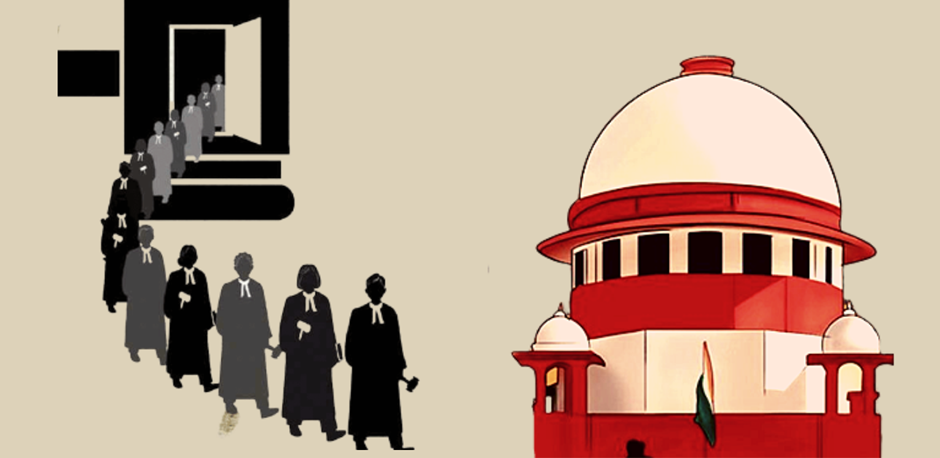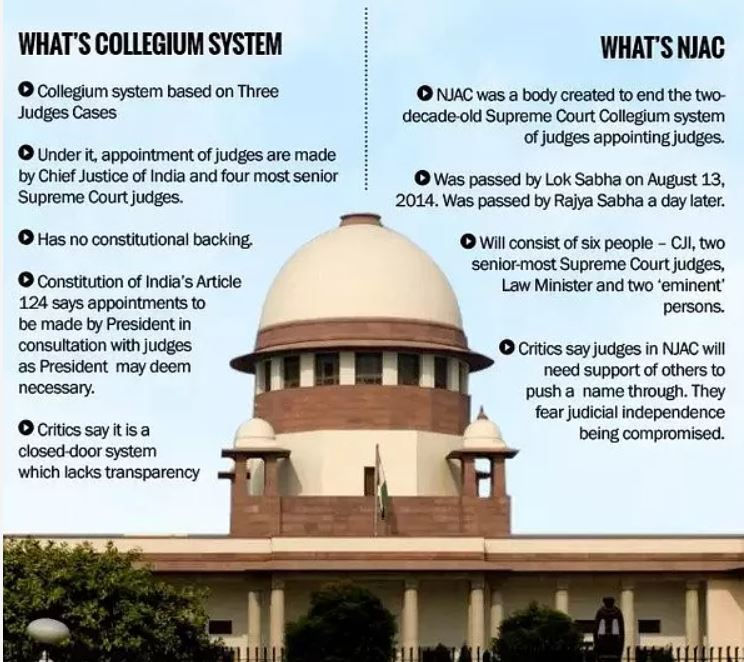- Courses
- GS Full Course 1 Year
- GS Full Course 2 Year
- GS Full Course 3 Year
- GS Full Course Till Selection
- MEP (Mains Enrichment Programme) Data, Facts
- Essay Target – 150+ Marks
- Online Program
- GS Recorded Course
- NCERT- First Ladder
- Polity
- Geography
- Economy
- Ancient, Medieval and Art & Culture AMAC
- Modern India, Post Independence & World History
- Environment
- Governance
- Science & Technology
- International Relations and Internal Security
- Disaster Management
- Ethics
- Current Affairs
- Indian Society and Social Issue
- CSAT
- 5 LAYERED ARJUNA Mentorship
- Public Administration Optional
- ABOUT US
- OUR TOPPERS
- TEST SERIES
- FREE STUDY MATERIAL
- VIDEOS
- CONTACT US
Effective Consultation in Judicial Appointments
Effective Consultation in Judicial Appointments
14-09-2024

Recently, the Supreme Court (SC) emphasized the importance of seniority and effective consultation in the appointment of High Court judges.
- In a case involving the Himachal Pradesh High Court (HC) collegium, the SC ruled that a 'lack of effective consultation' in judicial appointments is subject to judicial review.
- The Court directed a reconsideration of two judicial officers recommended for elevation, showing the importance of procedural adherence.
Background of the Case and SC Ruling
Background:
- In December 2022, the Himachal Pradesh HC collegium recommended two District judges for elevation to HC judgeships.
- The SC collegium requested reconsideration of these recommendations.
- Later, the HC collegium suggested two other judicial officers. The initially recommended judges challenged this in the SC, claiming their seniority was ignored.
Supreme Court Ruling:
- Review Authority: The SC looked at whether it had the power to review appointment recommendations, referencing past cases.
- Focus of Review: The SC decided its review would only check if "effective consultation" had taken place, not the candidates' qualifications.
- Proper Procedure: The SC checked whether the HC Chief Justice had consulted with other judges of the High Court.
- Ruling: The SC ruled that the Chief Justice could not make recommendations alone. Decisions must involve "collective consultation" with the Chief Justice and the two senior-most judges of the HC, ensuring adherence to procedures.
Procedure for the Appointment of High Court Judges
Procedure Overview:
- The collegium system, established through landmark cases (Second Judges Case, 1993; Third Judges Case, 1998), empowers the judiciary to recommend appointments and transfers of judges with limited government involvement.
The process for High Court appointments involves:
-
High Court Collegium Recommendation:
- The Chief Justice of the High Court, in consultation with the two senior-most judges of that court, recommends names for appointment.
-
State-Level Review:
- Recommendations are forwarded to the Chief Minister and Governor for their views (they cannot reject).
-
Central Government Process:
- The Governor sends recommendations to the Union Minister of Law and Justice for a background check.
- Supreme Court Collegium Review:
- Recommendations are then reviewed by the CJI and the SC collegium. If approved, names are sent to the President for final approval.
Government Role:
- The government can delay appointments or raise concerns but cannot overrule the collegium’s recommendations.
Collegium System of Judicial Appointments
About:
- The collegium system for appointing and transferring Supreme Court and High Court judges evolved through Supreme Court judgments and is not established by Parliament or the Constitution.
Evolution:
-
First Judges Case (1981):
- Also known as S.P. Gupta v. Union of India.
- The ruling gave primacy to the Executive in judicial appointments, allowing rejection of CJI's recommendations for strong reasons.
-
Second Judges Case (1993):
- Supreme Court Advocates-on-Record Association vs Union of India.
- Introduced the collegium system, where "consultation" meant "concurrence," making SC collegium’s recommendations binding and granting the judiciary authority over appointments.
-
Third Judges Case (1998):
- Expanded the collegium to a 5-member body including the CJI and 4 senior-most SC judges.
- Outlined limited grounds for challenging recommendations: lack of "effective consultation" or candidate ineligibility.
Head of Collegium System:
- SC Collegium is headed by the CJI and comprises 4 senior-most SC judges.
- HC Collegium is led by its Chief Justice and 4 senior-most HC judges.
Demerits of the Collegium System
-
Lack of Transparency:
- Criticized for being opaque with limited public insight into the appointment process.
- Nepotism:
- Concerns about personal connections influencing appointments, potentially leading to favoritism.
- Inefficiency:
- Absence of a permanent commission can cause delays and inefficiencies in filling vacancies.

Conclusion
The ongoing debate on judicial appointments highlights the need for reforms to enhance transparency, accountability, and efficiency. Potential reforms, including revisiting the National Judicial Appointments Commission (NJAC) or similar measures, could address these concerns and improve the judiciary’s operations.
Must Check: Best IAS Coaching In Delhi
UPSC Prelims Result 2024 Out: Expected Cut Off & Other Details, UPSC Prelims 2024 Answer with Explanation, Daily Prelims Quiz, Daily Current Affairs, MONTHLY CURRENT AFFAIRS TOTAL (CAT) MAGAZINE, Best IAS Coaching Institute in Karol Bagh, Best IAS Coaching Institute in Delhi, Daily Mains Question Answer Practice, ENSURE IAS UPSC Toppers, UPSC Toppers Marksheet, Previous Year Interview Questions, UPSC Syllabus




